What Is the Cause of Baby Rashes on the Face
Skin rashes in babies
It's normal for babies to develop rashes from as early as a few days old. If your baby has a rash but doesn't bear witness signs of illness, speak to your midwife, health visitor, or your GP. If your baby appears unwell, call your GP or GP out of hours service.
Almost skin rashes in babies
It'south of import to be aware of the symptoms of meningitis, run into section below.
Too beneath is data on some of the virtually common rashes in babies. Most rashes are harmless and go away on their own.
This guide may give you a better idea of the cause of the rash. But don't employ it to diagnose your baby'southward condition. Ever speak to a health professional person for a proper diagnosis.
- read most causes of rashes in older children
Infant acne (neonatal acne)
Babe acne is where pimples sometimes develop on a baby's cheeks, nose and forehead within a month of their nascence.
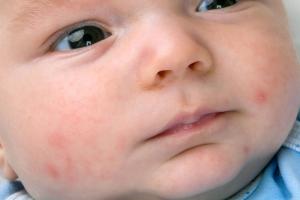
Nearly baby acne
- pimples tend to go worse before clearing up completely afterward a few weeks or months
- washing your infant's face with water and a mild moisturiser tin improve the appearance of their skin
- avoid acne medicines intended for older children and adults
Pimples or blackheads that develop later three months of age (infantile acne) tend to be more astringent. These often need medical treatment.
Cradle cap
Cradle cap is where yellowish, greasy, scaly patches develop on a infant's scalp.
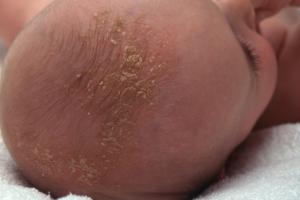
Well-nigh cradle cap
- occasionally, as well equally the scalp, the face up, ears and neck are likewise affected
- it isn't itchy and shouldn't bother your baby- if your baby is scratching or upset, they may take eczema (see beneath)
- it is a common condition that tends to develop within ii or iii months later on birth
- it commonly gets better without handling in a few weeks or months
Gently washing your baby's hair and scalp with baby shampoo may assistance to forestall further patches developing.
Eczema
Eczema is a long-term condition that causes the skin to become itchy, red, dry and croaky.
The near common form is atopic eczema. It mainly affects babies and children but tin can proceed into adulthood.
About atopic eczema
- eczema in babies under six months is sometimes associated with allergies to milk and egg
- it oft starts in immature babies every bit a red, itchy rash on the face, scalp and trunk
- as the child gets older, it usually starts to develop in areas with folds of skin, such as behind the knees or on the front of the elbows
Creams and ointments tin can often relieve the symptoms.
Erythema toxicum
Half of all newborns develop a blotchy cherry-red pare reaction called erythema toxicum. This is unremarkably at two or three days old.
It's a normal newborn rash that won't bother your babe and clears after a few days.
Manus, foot and mouth disease
Hand, foot and rima oris disease is a common, viral illness.
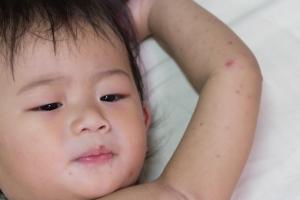
Almost paw, foot and mouth disease
- information technology causes a blistery rash on the palms of the easily and soles of the feet, also equally ulcers in the mouth
- your babe may also experience unwell and have a fever
Treatment isn't usually needed, every bit the infant'south immune system clears the virus. The symptoms get abroad later almost vii to 10 days. If you're worried, see your GP.
Hives (urticaria)
Hives is also known every bit urticaria.
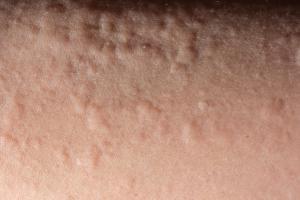
Near hives
- causes a raised, cherry-red itchy rash that appears on the pare
- happens when a trigger (such as a nutrient that your baby is allergic to) causes a substance chosen histamine to be released into their skin
If your baby gets urticaria during feeding, the status may be triggered by something they've had to eat or drinkable. The almost common foods are egg and milk, but many other foods can sometimes be the cause.
The urticaria rash is usually short-lived and can be controlled with antihistamines. If your baby gets hives repeatedly, it'southward important to see your GP to discuss possible allergies.
Impetigo
Impetigo is a highly contagious bacterial infection of the surface layers of the pare. It causes sores and blisters.
It's not ordinarily serious, but yous tin can visit your GP for a prescription of antibiotics. This should clear the infection inside vii to 10 days.
Milia
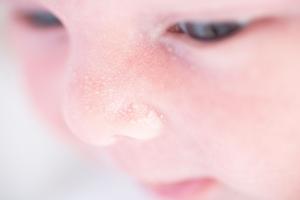
Most half of all newborns develop tiny (i-2mm) white spots on their face up. These are called milia.
These are just blocked pores. They unremarkably clear within the first 4 weeks of life.
Nappy rash
Nappy rash occurs when the skin effectually the baby'southward nappy expanse becomes irritated.
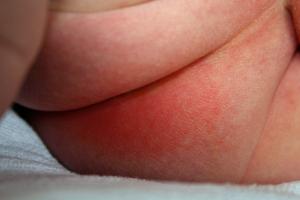
About nappy rash
- is often caused by exposure to wee or poo for a long period of fourth dimension
- tin can sometimes be the event of a fungal infection or rare skin condition
You tin unremarkably reduce nappy rash past taking uncomplicated steps to keep your baby'due south skin clean and dry. You can employ a barrier cream if needed. Antifungal cream may be necessary if the rash is caused by a fungal infection.
- read more about nappies and nappy rash
Ringworm
Ringworm is a common fungal skin infection. Information technology causes a ring-similar red rash about anywhere on the body (the baby's scalp, anxiety and groin are mutual areas).
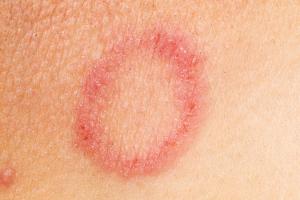
Information technology's normally easily treated using over-the-counter creams.
Ask your chemist if you need advice near treatment.
Scabies
Scabies is a common infestation of the skin that can affect people of all ages.
About scabies
- information technology'south caused by tiny mites that burrow into the skin
- it's often spread between family members, so when babies become scabies it's unremarkably because someone else in the family unit had it recently
- babies with scabies develop tiny and very itchy spots all over the body, including on the soles of the feet, armpits and genital area
Treatment with creams that kill the scabies mite needs to be given to the whole family at the same time for it to be effective.
Visit your GP if you recollect your infant has scabies. It's not normally a serious condition, but it does need to be treated.
Your GP will discuss treatment with you. The treatments about widely used are a cream and lotion.
Slapped cheek syndrome
Slapped cheek syndrome is a viral infection particularly common in children and babies.
Virtually slapped cheek syndrome
- it typically causes a bright crimson rash on both cheeks and a fever
- near babies won't need handling, as slapped cheek syndrome is usually a mild condition that passes in a few days
Sweat rash (miliaria)
A heat rash is sometimes chosen miliaria or prickly heat. It may flare up when your baby sweats. For case, considering they're dressed in too many clothes or the environment is hot and humid.
It'southward a sign your infant'southward sweat glands accept go blocked.
They may develop tiny red bumps or blisters on their pare, but these will soon clear without treatment.
Meningitis
Meningitis is an infection of the protective membranes that surround the brain and spinal cord (meninges).
Well-nigh meningitis
- the classic rash associated with meningitis ordinarily looks like small, red pinpricks at first
- it then quickly spreads over the torso and turns into ruby-red or imperial blotches
- information technology is a blotchy rash that doesn't fade when a drinking glass is rolled over it (this won't always develop)
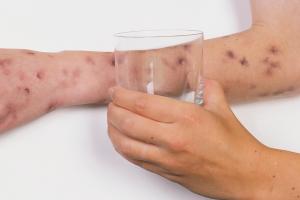
Meningitis alarm signs
Information technology's important to be enlightened of the warning signs of meningitis in your infant, which include:
- becoming floppy and unresponsive, or stiff with jerky movements
- condign irritable and not wanting to exist held
- unusual crying
- vomiting and refusing feeds
- pale and blotchy skin
- loss of ambition
- staring expression
- very sleepy with a reluctance to wake up
- fever
Some babies develop a swelling in the soft part of their head (fontanelle).
Trust your instincts. If you lot think your baby has meningitis, come across your GP or GP out of hours service immediately or become to your nearest emergency department.
- discover out more about skin rashes in babies on the NHS website
More useful links
- How to utilise your health services
The information on this folio has been adapted from original content from the NHS website.
For further information see terms and atmospheric condition.
What Is the Cause of Baby Rashes on the Face
Source: https://www.nidirect.gov.uk/conditions/skin-rashes-babies